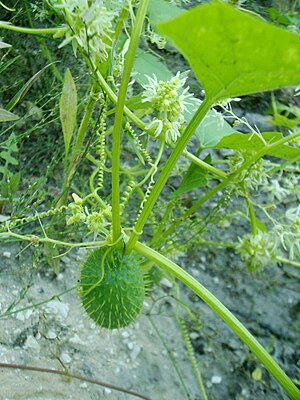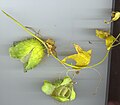Pickle cucumber
| Pickle cucumber | ||||||||||||
|---|---|---|---|---|---|---|---|---|---|---|---|---|

Cucumber ( Echinocystis lobata ) |
||||||||||||
| Systematics | ||||||||||||
|
||||||||||||
| Scientific name of the genus | ||||||||||||
| Echinocystis | ||||||||||||
| Torr. & A.Gray | ||||||||||||
| Scientific name of the species | ||||||||||||
| Echinocystis lobata | ||||||||||||
| ( Michx. ) Torr. & A.Gray |
The chayote ( Echinocystis lobata ), also lobed chayote or hedgehog cucumber called, is the only way the plant genus Echinocystis within the family of cucurbits (Cucurbitaceae). It is native to North America and partially wild in Central Europe.
description

Vegetative characteristics
The cucumber is a climbing, annual herbaceous plant . The five-edged and hollow, almost bare stems are up to 8, rarely 10-12 meters long and are heavily branched in the upper area. The tendrils are in three parts.
The alternately arranged, soft leaves are divided into a long petiole and leaf blade. The leaves are up to 21 centimeters in size. The leaf blade , which is three to seven times lobed, has a blunt to heart-shaped, spear-shaped or arrow-shaped blade base. The leaf lobes are triangular and pointed. The leaf margin is slightly toothed, the upper side is scaly and rough, the underside is lighter. The tips of the lobes are soft and spiky and the edges of the leaves are distantly covered with short, thick hairs on the vein ends. Stipules are missing. The knotted , twisted or curled tendrils are light green.
Generative characteristics
The prickly cucumber is monoecious separately sexed ( monoecious ); H. male and female flowers are formed on an individual plant.
There are panicles or traubige formed inflorescences. The unisexual flowers are six-fold, radial symmetry with a double flower envelope . The male flowers appear first, in larger groups, with the mostly single to a few female flowers just below them. The flowers have a small hairy stem.
The small calyx lobes are 1.5 to 3 millimeters long and pale. The corolla is white to yellowish white. The six long, often twisted corolla lobes are narrow-triangular and have glandular-shaggy hair on both sides. The corolla lobes of the male flowers are up to 9 millimeters long, those of the larger female flowers up to 12 millimeters long. The six stamens are fused into three groups of two and are close to fused together, they have greenish and S-shaped anthers with triple bars. The spiky soft, under constant ovary is zweikammerig, each having up three ovules per chamber, with a thick, short pen with wider, thicker, and lobed scar .
The ellipsoidal, greenish berry fruit (armored berry, pepo) with a length of 3 to 5 centimeters has soft spines up to 10 millimeters long. The one to six, flattened, elliptical seeds are about 1.5 to 1.8 inches long and dark brown to blackish. The berry opens irregularly at the top, releasing the seeds. The seed chambers develop into a fine, white "network" in which the seeds lie. Hence the name -cystis , from the Greek kystis , for sack or bladder, blater in the species name .
The number of chromosomes is 2n = 32 or 34.
Distribution and locations
The prickly cucumber is common in large parts of North America. It is only found in northern Canada , in southwest ( California ) and southeast (Florida to Louisiana ) USA. In their homeland they can also appear as “ weeds ”, for example in river valleys in maize and soybean fields , where they make harvesting difficult. Sometimes in America it also grows in hedges and bushes of the lowlands.
In Central Europe, the cucumber is naturalized as a neophyte . It grows in Central Europe in the summer-warm, nutrient-rich bank fringes of the colline altitude . It forms mass populations in the western part of Romania (between Valea Lui Mihai, Carei and Satu Mare) and overgrows the shrub and tree vegetation at the roadsides, so that it has become a character species of the Cuscuto-Convolvuletum from the Senecion fluviatilis association .
In Germany, the cucumber is found in the middle Rhine and Elbe valleys , in the lower Neckar valley and in the middle Saale valley and is common in the Lower Oder Valley National Park . In Austria it occurs in southern Burgenland , in the March and lowest Thayatal (Lower Austria), in Upper Austria , in eastern Styria and inconsistently in North Tyrol . In Switzerland, it was included in the black list of invasive neophytes due to its potential for spreading and the damage in the areas of biodiversity , health and economy .
Systematics and Etymology
The first publication took place in 1803 under the name ( Basionym ) Sicyos lobatus by André Michaux . The new combination to Echinocystis lobata was published in 1840 by John Torrey and Asa Gray . The generic name Echinocystis is made up of the Greek words echinos for "hedgehog" and kystis for "urinary bladder" and refers to the prickly fruits. The specific epithet lobata means lobed. The genus name Echinocystis Torr. & A.Gray nom. cons. is through Melbourne ICN Art. 14.4 & App. III preserved against Micrampelis Raf. nom. rej. Another synonym of Echinocystis Torr. & A.Gray is Hexameria Torr. & A.Gray .
Echinocystis lobata is the only remaining species of the genus Echinocystis from the tribe Sicyeae in the subfamily Cucurbitoideae within the family Cucurbitaceae . The previously different Echinocystis species were integrated into the sister taxon , the genus Marah .
There are several synonyms; Echinocystis echinata (Muhl. Ex Willd.) Britton, Sterns & Poggenb. , Echinocystis echinata Vassilcz. , Micrampelis echinata (Muhl. Ex Willd.) Raf. , Micrampelis lobata (Michx.) Greene , Momordica echinata Muhl. ex Willd. , Sicyos lobatus Michx. and Hexameria echinata (Muhl. ex Willd.) Torr. & A.Gray .
use
It is sometimes used as an ornamental plant.
photos
Habit and flowers
literature
- Manfred A. Fischer, Karl Oswald, Wolfgang Adler: Excursion flora for Austria, Liechtenstein and South Tyrol . 3rd, improved edition. State of Upper Austria, Biology Center of the Upper Austrian State Museums, Linz 2008, ISBN 978-3-85474-187-9 .
- Siegmund Seybold (Ed.): Schmeil-Fitschen interactive . CD-ROM, version 1.1. Quelle & Meyer, Wiebelsheim 2002, ISBN 3-494-01327-6 .
- Zoltán Botta-Dukát, Lajos Balogh: The most important invasive plants in Hungary. HAS Institute of Ecology and Botany, 2008, ISBN 978-963-8391-42-1 , pp. 103-114, online (PDF; 4.6 MB), at researchgate.net, accessed October 22, 2018.
Web links
- Wild Cucumber Echinocystis lobata (PDF), from Nature Manitoba, accessed October 22, 2018.
- Echinocystis lobata (Michx.) Torr. & A. Gray, Lobed Cucumber. In: FloraWeb.de.
- Thomas Meyer: Data sheet with identification key and photos at Flora-de: Flora von Deutschland (old name of the website: Flowers in Swabia ) .
Individual evidence
- ↑ a b c From web link; Wild Cucumber Echinocystis lobata (PDF), from Nature Manitoba.
- ^ Klaus Kubitzki : The Families and Genera of Vascular Plants. Vol. X, Springer, 2011, ISBN 978-3-642-14396-0 , pp. 143 f.
- ↑ a b Erich Oberdorfer : Plant-sociological excursion flora for Germany and neighboring areas . With the collaboration of Angelika Schwabe and Theo Müller. 8th, heavily revised and expanded edition. Eugen Ulmer, Stuttgart (Hohenheim) 2001, ISBN 3-8001-3131-5 , pp. 679 .
- ↑ USDA data sheet , accessed April 5, 2008.
- ^ Weeds of the North Central States ( Memento of September 10, 2006 in the Internet Archive )
- ↑ Anna Szabó, Annamária Fenesi, Attila Mátis: Vegetation of the river Tur protected area. ( Flora şi fauna rezervaţiei naturale Râul Tur. ) In: Biharean Biologist. 2008, (supplement), pp. 27-38.
- ^ Federal Office for the Environment FOEN: Invasive Alien Species . ( admin.ch [accessed on August 6, 2019]).
- ↑ S. Buholzer, M. Nobis, N. Schoenenberger, S. Rometsch: List of the alien invasive plants of Switzerland . Ed .: Infoflora. ( infoflora.ch [accessed on August 6, 2019]).
- ↑ Echinocystis in the Germplasm Resources Information Network (GRIN), USDA , ARS , National Genetic Resources Program. National Germplasm Resources Laboratory, Beltsville, Maryland. Retrieved December 28, 2015.
- ↑ Alexander Kocyan, Li-Bing Zhang, Hanno Schaefer, Susanne S. Renner : A multi-locus chloroplast phylogeny for the Cucurbitaceae and its implications for character evolution and classification. In: Molecular Phylogenetics and Evolution. Volume 44, 2007, pp. 553-577, doi : 10.1016 / j.ympev.2006.12.022 , online (PDF), at University of Missouri-St. Louis.




